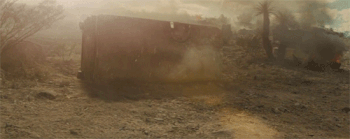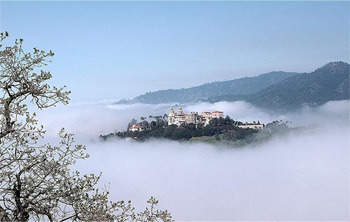7 Times Being Totally Cheap Resulted In Movie Magic

Usually, when we hear about movie budget cuts, it's because something went terribly wrong, and the end product is such a steaming pile of offal that everyone, from the average audience member to average theater projector operator, is demanding answers. Once in a blue moon, however, it's the budget limitations themselves that elevate a movie from a permanent spot in a drug store clearance bin to a cultural landmark that we're still talking about decades later.
Back To The Future's Original Plan For Time Travel Was Too Expensive

Other than Doc Brown's gloriously wild halo of hair, the first thing everyone thinks of when they hear the words "Back To The Future" is that sweet-ass DeLorean, with its super cool vertical hatch doors and magical time-travelling abilities. Sure, the hoverboard is cool enough, but it can't hold a candle to that iconic car.
The Original Plan
Which is why it's almost blasphemy to learn that the DeLorean was supposed to be a pickup truck, and the time machine itself was a laser device inside an old-timey refrigerator in the back of said pickup. In the original draft, getting back to the future wasn't a matter of collecting energy from a clock tower during a perfectly-timed lightning strike; Marty was going to get back to 1985 by driving into a nuclear bomb explosion.

Which would have been a reasonable plot point, considering the American government was testing nuclear bombs left and right in the Nevada desert during the 1950s. So initially, when it was time to get Marty back to 1985, Doc and Marty would go to the desert, attach the laser-time-travel thing to the refrigerator, strap the refrigerator to the truck, instruct Marty to get in the refrigerator, then rig the truck so that it drives straight into a nuclear bomb explosion, where the whole contraption would get propelled through time. If this sounds familiar, it should. The concept was rejiggered for Indiana Jones And The Kingom Of The Crystal Skull.

There were two problems. One: Filming on location in Nevada wasn't in the budget. Two: Creating the effect of a nuclear explosion would cost a million dollars, according to Industrial Light & Magic -- which was money the team didn't have. Oh, and Zemeckis was also noticing that there was a rash of incidents wherein kids would crawl into old-fashioned refrigerators and get stuck inside after they latched shut. Attaching his name to action movie that might inspire more child suffocation deaths AND more nuclear explosions didn't sit well in his stomach. So they compromised by switching the time machine from a thermonuclear refrigerator to a terrible sports car designed by a cocaine trafficker.
Monty Python's Coconut Gag Was Created To Replace Expensive Horses

One of the first indications that Monty Python And The Holy Grail wasn't your ordinary historical comedy comes when the message from the royal court arrives, not on the backs of a fleet of purebred horses, but in the hands of a dude whose well-heeled heels are closely followed by a couple more guys banging some coconuts together to create the illusion of horse hoofs. It's perfect in its goofy simplicity. And it almost didn't happen.

The Original Plan
Like anyone else who wants to incorporate animals in a movie production, the original vision for Monty Python And The Holy Grail included living, breathing equines. The problem was that horses need trainers and stunt doubles and food and saddles -- not to mention a whole new coming-of-age character who learns about the value of friendship through the loyalty of a good animal who will definitely be put down by the end of the movie. Monty Python didn't have the budget for any of that stuff, so the horses were nixed altogether.

Instead, the Python gang substituted the clip-clop of trotting horses with coconuts, an effect with roots in BBC radio history. In fact, Python's spiritual grandparents, the comedy team behind The Goon Show, not only used the gag of coconuts for horse sounds in their programs, but they also made fun of the device, just like we see in Holy Grail. Here's a snippet from a 1955 Goon episode:
BLOODNOK: Hark! I hear horses hooves.
CARDIGAN: It's somebody galloping down the road.
BLOODNOK: Who is it?
CARDIGAN: It's a man with coconut shells strapped to his feet.
So when it became clear that there was no way they were going to be able to afford horses for their movie, Monty Python resorted to the oldest trick in the book: borrowing a 20-year-old joke and hoping no one would get mad about it.
The Texas Chainsaw Massacre's Horrifying Soundtrack Was All DIY

Before there was Freddy, Jason, or Michael Myers, there was Leatherface and his inbred, cannibalistic family. Part of what made L-Face and his batshit country home so menacing was the film's soundtrack, which pushed the audience into realms of audio torture previously reserved for magazine writers attempting to review a piece of Yoko Ono's performance art. The soundtrack was more of an amalgam of tension inducing-noises than a musical score, and it winds up doing half of the movie's work for it.
The Original Plan
Without money, or experience, or any fucking clue how to create music whatsoever, director Tobe Hooper enlisted the aid of sound recordist Wayne Bell and dove right in. Hooper got his hands dirty, creating many of the soul-shattering sounds himself, sitting on the floor and screaming into a cardboard tube like the goddamn maniac he is.

The dynamic duo manipulated the speed of their recordings, utilized broken instruments, and "tortured" an upright bass in the name of their art. All of which sounds about right, coming from the kind of person who would unleash a mentally unhinged actor on a helpless woman in a 115-degree room filled with rotting meat.
The Clueless Wardrobe Came From Desperation

The '90s were full of dirty-haired greaseballs running around in flannel and Doc Martens, singing unintelligible lyrics while being mad at their dads. But then a sunny blonde with a rotating closet came along and showed us what we (and conditioner) were truly capable of. The bright, trendy, clean styles worn by Cher and her girlfriends in the cult teen comedy Clueless were the motivation America needed to put down their cloves and go take a shower. And it was all totally by accident.
The Original Plan
Initially, everything in Cher's wardrobe was supposed to be high-fashion couture, in keeping with her spoiled attitude and gobs of money. But it turns out that filling a closet full of runway-ready duds ain't cheap. So costume designer Mona May took inspiration from her fictional muse and headed to the mall.
Except she got kicked out by the sixth time she played "Supermodel" on loop.
By blending vintage pieces with items that would be right at home on a Forever 21 rack, May was able to stretch her budgetand make the film's ladies look stellar. At the time, this sort of thing wasn't heard of, but for May, this was simply a creative way to dress her cast well and stay under budget. To this day, Clueless is commended for singlehandedly reversing the Gen Y fashion scene, and for delivering Donald Faison and Paul Rudd to a world that wouldn't quite be ready to receive them for another decade.

The Citizen Kane Crew Invented Shot Angles To Hide Their Poverty

Even if you haven't seen the movie, you probably know the main beats of Citizen Kane. Orson Welles plays Charles Foster Kane, a rich, mustachioed dying man whose grip on reality is as tenuous as his grip on his beloved snow globe. After Kane's death, we're treated to a newsreel explaining that he was once was a newspaper publisher who lived alone in a mansion the narrator mockingly calls "the costliest monument a man has built to himself." That fictional house was modeled after the equally elaborate, real-world 60,000 square foot home of William Randolph Hearst, aka Hearst Castle.

Hearst, the real Kane, collected exotic animals, European marble, art, furniture, fountains, 16th-century beds, Roman temples (that's right, temples that he bought from Europe) -- the usual. He was global-sized hoarder, in other words. So when Citizen Kane had to put together the look of their movie, they had to convey that they were representing a man who couldn't keep his hands off of every luxury the world had to offer. But they were making their movie with a tiny budget, because Orson Welles had never made a movie before and didn't know what the hell he was doing.
The Original Plan
There was no plan.
With a $800,000 budget and zero experience with cameras, Orson Welles made everything up as he went along, and as fast as he could. To learn camera work, he ordered a copy of the 1920 silent film The Cabinet Of Dr. Caligari and watched John Ford's Stagecoach over 40 times, basically memorizing every trick more accomplished directors had already figured out. And then he invented a few tricks of his own.
In order to convey the over-the-top opulence and insanity of Kane's mansion without having access to a mansion or all the stuff that should have filled it, Welles and his art director strategically used creative camera work and insane angles to give the illusion of wealth. Soundstages were transformed into mansions by angling the camera on the ground so viewers could see an exaggerated space. Here's Welles working the camera from a HOLE IN THE FLOOR, because his cameraman couldn't squat down low enough.

Now that the camera was looking up at his actors, Welles discovered a new problem: soundstages, unlike real buildings, don't have ceilings. If the camera is panning dead on the actors, you don't usually notice that there are lights and microphones where the ceiling would be. So Orson used muslin fabric and panelling to give the illusion of a complete room in every scene.

As for the mansion itself, Welles and his art director played very carefully with a few props to make you feel you were looking at a huge space. You're not. In reality, you're looking at a ginormous fireplace with an ornately carved chair in the foreground:

The room is big, but it isn't mansion big. When Kane's second wife makes her opera debut, tricky lighting implies she's on a stage in front of a crowded house. She's not. She's on a stage, but there is no audience.


If you think you remember Welles clapping angrily while hundreds of extras piled out of the opera house, then you're wrong. You remember Welles and a few dimly-lit people sitting near him, bluffing his way through one of the most influential movies ever made.

Godzilla Was Supposed To Be A Stop-Motion Octopus

Despite a slew of terrible sequels and remakes, Godzilla endures as the world's favorite giant sea-based movie monster that is clearly a man in a rubber suit. Even with modern CGI and millions of dollars to throw at a budget, modern audiences still cling to the image of a guy in an inelegant dinosaur costume, because Godzilla's low-budget cheesiness is a big part of what makes him so endearing.

The Original Plan
Try to imagine the original Godzilla as an enormous stop-motion octopus. Special effects wizard Eiji Tsuburaya signed on to create the creature featured in the Japanese film Gojira, which he hoped would be the perfect vehicle for his giant octopus idea. Other possibilities included an ape-like creature, inspired by the granddaddy of film freaks, King Kong, a marvel in stop-motion animation in its day.
Thankfully, Tsuburaya was given mere months to complete his work, versus the years he would have needed to realize his ambitious interpretation. With little time and less money, he settled on the rubber suit, and a saurian star was born.
All leading to the greatest moment ever filmed.
Planet Of The Apes Was Supposed To Be Much More Modern

The most recognizable aspect of Planet Of The Apes is that epic shot of the Statue of Liberty half-buried in the sands of an apocalyptic wasteland. That shit was so awesome that they slapped it on the cover, spoilers be damned. It's either that or that one iconic quote. You know the one.

The Original Plan
Somewhere floating around the abyss of abandoned Hollywood scripts is a version of Apes written by none other than The Twilight Zone's Rod Serling. This version would have explored the apes rising in a much more modern setting, with clothing shops, vehicles, and bustling city streets. Except the mannequins were monkey-shaped and the coffee shops all sold banana smoothies.
Producers started having second thoughts, worried that Serling's version would have cost too much to bring to life, what with all the houses and shopping malls and things you can see in literally any neighborhood anywhere in America. The Apes producers rode their flawed logic to a conclusion that brought on a whole new writer and whole new construction crew to create the devastated dystopia we've all come to know and love. But suburbia is everywhere; apocalyptic wastelands really kind of aren't ... unless you live in Detroit.
So not only did the producers end up spending more money on their "conservative" version of the film, but they robbed the world of the greatest moment in cinematic history:

Gorilla. Policeman. This is the one remake we can't wait to see happen, and we're halfway there.
Share your Planet Of The Apes featuring gorilla policeman petition with Carolyn on Twitter.
Hurry! Our Back To School Sale is ending Sunday and so is your last chance to finally be cool. Go to the Cracked Dispensary and get yourself free shipping with the code SCHOOLDROOLS. Buy one before the popular kids snatch them all up.
Also be sure to check out 6 Great Movies That Were A Disaster Behind The Scenes and The 6 Stupidest Things The Hobbit Movies Wasted Money On.
Subscribe to our YouTube channel to learn about some cheap inanimate objects that are way more famous than you are in 7 Most Overused Props In Hollywood History, as well as watch other videos you won't see on the site!
Also follow us on Facebook because we're lonely. So very lonely.